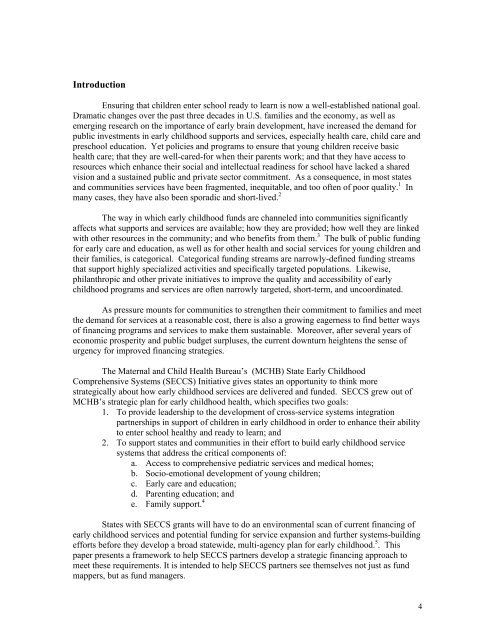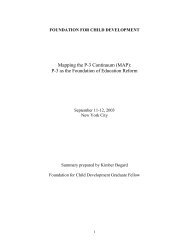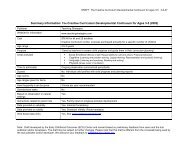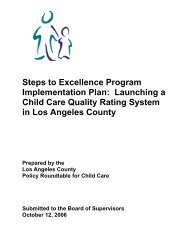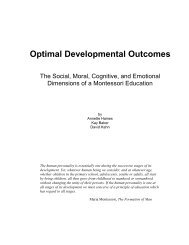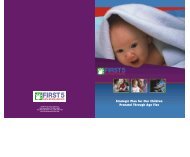STRATEGIC FINANCING: - National Academy for State Health Policy
STRATEGIC FINANCING: - National Academy for State Health Policy
STRATEGIC FINANCING: - National Academy for State Health Policy
Create successful ePaper yourself
Turn your PDF publications into a flip-book with our unique Google optimized e-Paper software.
Introduction<br />
Ensuring that children enter school ready to learn is now a well-established national goal.<br />
Dramatic changes over the past three decades in U.S. families and the economy, as well as<br />
emerging research on the importance of early brain development, have increased the demand <strong>for</strong><br />
public investments in early childhood supports and services, especially health care, child care and<br />
preschool education. Yet policies and programs to ensure that young children receive basic<br />
health care; that they are well-cared-<strong>for</strong> when their parents work; and that they have access to<br />
resources which enhance their social and intellectual readiness <strong>for</strong> school have lacked a shared<br />
vision and a sustained public and private sector commitment. As a consequence, in most states<br />
and communities services have been fragmented, inequitable, and too often of poor quality. 1 In<br />
many cases, they have also been sporadic and short-lived. 2<br />
The way in which early childhood funds are channeled into communities significantly<br />
affects what supports and services are available; how they are provided; how well they are linked<br />
with other resources in the community; and who benefits from them. 3 The bulk of public funding<br />
<strong>for</strong> early care and education, as well as <strong>for</strong> other health and social services <strong>for</strong> young children and<br />
their families, is categorical. Categorical funding streams are narrowly-defined funding streams<br />
that support highly specialized activities and specifically targeted populations. Likewise,<br />
philanthropic and other private initiatives to improve the quality and accessibility of early<br />
childhood programs and services are often narrowly targeted, short-term, and uncoordinated.<br />
As pressure mounts <strong>for</strong> communities to strengthen their commitment to families and meet<br />
the demand <strong>for</strong> services at a reasonable cost, there is also a growing eagerness to find better ways<br />
of financing programs and services to make them sustainable. Moreover, after several years of<br />
economic prosperity and public budget surpluses, the current downturn heightens the sense of<br />
urgency <strong>for</strong> improved financing strategies.<br />
The Maternal and Child <strong>Health</strong> Bureau’s (MCHB) <strong>State</strong> Early Childhood<br />
Comprehensive Systems (SECCS) Initiative gives states an opportunity to think more<br />
strategically about how early childhood services are delivered and funded. SECCS grew out of<br />
MCHB’s strategic plan <strong>for</strong> early childhood health, which specifies two goals:<br />
1. To provide leadership to the development of cross-service systems integration<br />
partnerships in support of children in early childhood in order to enhance their ability<br />
to enter school healthy and ready to learn; and<br />
2. To support states and communities in their ef<strong>for</strong>t to build early childhood service<br />
systems that address the critical components of:<br />
a. Access to comprehensive pediatric services and medical homes;<br />
b. Socio-emotional development of young children;<br />
c. Early care and education;<br />
d. Parenting education; and<br />
e. Family support. 4<br />
<strong>State</strong>s with SECCS grants will have to do an environmental scan of current financing of<br />
early childhood services and potential funding <strong>for</strong> service expansion and further systems-building<br />
ef<strong>for</strong>ts be<strong>for</strong>e they develop a broad statewide, multi-agency plan <strong>for</strong> early childhood. 5 . This<br />
paper presents a framework to help SECCS partners develop a strategic financing approach to<br />
meet these requirements. It is intended to help SECCS partners see themselves not just as fund<br />
mappers, but as fund managers.<br />
4


